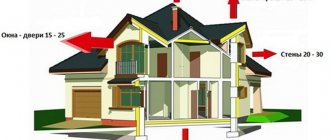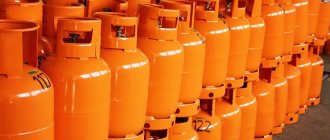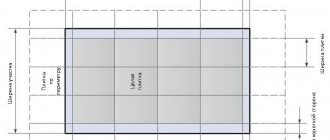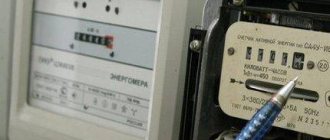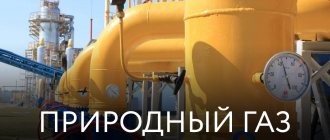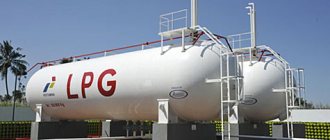Design and principle of operation of the product
A standard water heater is a metal box that is comparable in size to a kitchen cabinet. Inside it is the main system and mechanism that ensures the operation of the equipment. In addition, two pipes are connected to the box, which are responsible for the supply of water and gas.
The design itself consists of the following basic elements:
- rear panel.
- draft cap.
- gas and water supply valves.
- copper heat exchanger.
- main burner.
- pilot burner.
- electronic circuit.
- battery compartment.
When the water tap is opened, a valve in the mechanism is activated, through which gas is supplied to the pilot burner, which is responsible for igniting the main burner. This process directly depends on the type of equipment ignition. During the combustion of fuel, the amount of thermal energy that is necessary to heat water to a certain temperature is released. Thermal energy passes through a spiral-shaped heat exchanger, resulting in rapid heating.
After the water is heated to the desired temperature, the process of supplying it from the column to the open tap, through the outlet pipe, is carried out. The gas combustion products formed during operation are released into the atmosphere through ventilation or a chimney, which is a prerequisite for installing such a heating system.
It is also important to know that geysers presented by manufacturers on the market are of two types:
- storage water heater;
- a flow-type device operating from a gas supply.
Characteristics that you need to pay attention to when choosing the optimal model:
- amount of hot water consumed. Using the device simultaneously by several residents may result in insufficient heated liquid accumulated in the heating tank.
- use with a centralized pipeline is not recommended by experts, as there is a possibility of insufficient pressure.
- installation feature. Storage tanks of the device, as a rule, are large in size (depending on the volume of liquid contained), so there is a need for a suitable location (floor or solid wall).
Advantages of instantaneous water heater
Having decided to acquire this type of device, you first need to familiarize yourself with its main characteristics, model range, leading market manufacturers, as well as the advantages inherent to the device.
Advantages of gas models:
- a gas flow-through heater is a budget option. This fact is explained by the fact that gas, which serves as the main fuel, is quite cheap in price compared to similar sources such as electricity, gasoline, etc.
- The power of the city gas supply system is usually enough to install such a water heater at home.
- availability of several connection options - to natural and liquefied gas.
- affordable pricing policy of manufacturers.
- multifunctionality. With their help, you can simultaneously provide hot water not only to the kitchen, but also to the bathroom with shower.
- Compact dimensions allow installation in rooms with limited space. The system does not take up much space, leaving space for more efficient use.
- Fast heating is a feature that other devices used for these purposes, for example, storage columns, cannot offer. The latter are the optimal solution for those who consume large quantities of hot water, but the heating process still requires time.
The average power of flowing gas equipment is 18-19 kW, which is quite enough for the normal life of the residents of the house. In addition to the technical parameters, it is also important to mention the appearance. The modern design of the products is significantly different from previous analogues, and goes well with the elements of any interior.
In what cases can a recalculation be made?
In some cases, it is possible to recalculate gas payments in the absence of meters. They are described below.
Temporary absence
Until 2021, it was enough to submit an application to carry out the recalculation. Currently, Decree of the Government of the Russian Federation No. 354 (clause 86) gives such a right only if it is impossible to install a meter, which must be confirmed by the commission by issuing an inspection report. If you have such a right, an application is submitted to the gas supplier organization accompanied by documents proving temporary absence (more than 5 days).
Changing the number of registered people
For recalculation, an application is submitted and documents are attached confirming the departure (discharge) of previously registered residents. Calculations will be made based on the number of registered residents. If the registered citizens do not actually live for a long time or have even left the region, then this fact will have to be proven in court by attracting witnesses.
You do not live at this address
Calculations will be made based on the number of apartment owners, regardless of their place of residence.
Recalculation requires submitting an application to the gas supply organization and providing evidence . Disputes are resolved in court.
Equipment disadvantages
One of the significant disadvantages of this type of heating apparatus is the fire safety and explosion hazard of the fuel used during operation. In case of breakdowns, repair work must be carried out immediately. Only in this case will it be possible to avoid undesirable consequences in the form of fuel leakage, which negatively affects the human respiratory tract.
Before purchasing and installing such a water heater, you must first evaluate the supply power in the gas supply lines. If it is insufficient, then installation is absolutely not possible. In such cases, only storage type equipment can be installed.
The performance of the speaker can be significantly affected by the level of humidity in the room where it is installed. It is worth remembering that some manufacturers do not recommend installation in wet areas, and do not provide appropriate guarantees if this condition is violated.
Legislative acts
One of the fundamental documents of the housing and communal services sector is considered to be Law No. 69-FZ of March 31, 1999 “On gas supply in the Russian Federation”. Resolution of the Government of the Russian Federation dated 02/05/98 No. 162 approved the rules for gas supply to the population, which were clarified by Resolution No. 549 dated 07/21/2008.
To more fully meet the needs of the population and increase the efficiency of gas supply, methods for calculating payments and accounting for gas consumption are constantly being improved:
- The foundations are laid by the Gas Accounting Rules.
- The procedure for payments for all types of energy is approved by Decree of the Government of the Russian Federation dated April 4, 2000 No. 294.
- Guidelines for calculating the cost of gas for the population are determined by Order of the Federal Tariff Service of the Russian Federation dated October 27, 2011 N 252-e/2.
Safety level of a household geyser
Among specialists working with gas appliances, there is an opinion that safety lies in the details. This is precisely the statement that applies to the type of equipment under consideration. Most manufacturers are trying to improve their models as much as possible by introducing various sensors and systems.
Very often on the market you can find speakers with LED screens that report on the functional status of the device, possible breakdowns and failures. They also contain a number of parts and devices that make using the water heater more convenient and safe:
- modern thermostats allow you to adjust the level of heating and supply of hot liquid in the event of a change in pressure in the water supply system. That is, by reducing the pressure in the pipes, the risk of supplying boiling water, which can get burned, is eliminated. At the same time, it is also possible to adjust the flow rate of the consumed liquid and the power of the burner.
- When there are changes in the gas supply, the burner is able to independently adjust the height of the flame produced. The presence of a safety valve allows you to block the fuel supply if the tap is closed, thereby minimizing the likelihood of overheating.
- draft sensor - responsible for stopping the gas supply in the event of reverse draft formation or its complete absence.
- timer – allows you to program the time for turning off the column.
- The automatic heating system prevents the equipment from freezing when the room temperature drops.
How to choose the optimal water heater model?
The primary selection criterion is the performance of the device and the purpose of its use. As a rule, for private homes where water can be used simultaneously in the kitchen, bathroom, and shower, models with a power of 23-24 kW, flowing up to 15 l/min, are considered optimal. If you only use a shower and a kitchen tap, then a power of 17-18 kW is sufficient, providing 10-11 l/min.
Of course, the power of the equipment can be adjusted (decreasing or increasing the height of the burner flame):
- manual adjustment - changing the position of the handle will allow you to adjust the thermal power. With a large flow of water, the temperature will be lower, and the opposite situation with a low flow.
- automatic adjustment - the flame height is independently adjusted based on the amount of liquid flow.
Ignition type
Ignition in modern models can be carried out in several ways:
- piezo ignition.
- automatically from a battery spark.
- automatically from a hydraulic turbine spark.
The first of the presented methods, the most outdated, involves the conversion of mechanical movement into an electrical discharge. When turned on for the first time, the user needs to press a button, which will activate the built-in piezoelectric element. The spark formed during the process will ignite the igniter and the main burner. Apart from the number of manipulations performed, this method is not economical. When ignited, the igniter burns for some time, thereby consuming gas (an increase in raw material consumption by a quarter has been recorded).
The last two methods do not require human intervention. When the tap is unscrewed, the ignition starts automatically, as well as the fan and the supply of combustible material. The only difference between them is the source of spark formation. For example, the operating life of a battery is about a year, and in the case of a hydraulic turbine, it is necessary to monitor the pressure, it should be no lower than 0.45 atm.
Popular manufacturers
An important criterion when choosing is the company’s image, its experience, production capacity, and ongoing modernization. The reliability of the finished column depends on the professionalism of the workers, and largely on the company. Let's look at the main players in the market:
- Neva is a model of quality that meets European standards. When designing their models, the designers paid special attention to the safety parameter, so the product can contain many programs that make the models much more stable and reliable.
- Bosch, as a rule, equips its equipment only with modern developments, which not only increase functionality, but also guarantee a high level of security.
- Oasis – manufactures equipment that fully corresponds to the quality and prices set. The mechanisms of this TM are not as expensive as the previous ones, but they have the necessary set of additions.
Each of these manufacturers presents on the market models with different characteristics and parameters, which may also differ in the way combustion products are removed:
- atmospheric (open chamber) - all substances are removed through the chimney.
- turbocharged (closed chamber).
User reviews
Alexey Revenko, Moscow
I have been using a Neva Transit gas water heater for 3 years now. It is very convenient to manage, since it does not require unnecessary knowledge and skills from me; everything is controlled by a standard program. I would like to note that this type of heating is more profitable than centralized supply. In the latter case, it was very difficult to count on even warm or room temperature, but now I have the opportunity to choose the degree of heating myself, while saving significantly.
Nina Alekseeva, Ekaterinburg
After purchasing a new apartment, we immediately began replacing the plumbing and all related components. We thought for a very long time about what to do with the central water supply, and the craftsmen advised us to use a gas water heater, since the pressure in the pipes facilitates installation. I can say one thing: we were very pleased with the resulting effect and never regretted it.
Oleg Golod, Perm
This type of technology is a real find. This is what it means: technological progress does not stand still. Despite the fact that I only recently purchased the Neva 4011, I have already experienced all the advantages.
Useful article? Rate it and add it to your bookmarks!
How do you pay for gas without a meter?
How do you pay for gas without a meter?
Gas stove
So, if the apartment has a gas stove (but no gas water heater or gas heating), then it is assumed that each tenant spends 10 cubic meters of gas per month. A family of three people - 30 cubic meters, of five people - 50 cubic meters.
This calculation method is beneficial to the management company, but not to consumers. After all, you cook for the whole family at once, and not everyone for themselves. And small children do not use gas at all.
One cubic meter of gas in the second half of 2021 in Novosibirsk costs 5.835 rubles.
It turns out that each resident of an apartment with a gas stove pays 58 rubles 35 kopecks per month.
There are three Ivanovs in the family; gas costs them 30 × 5.835 = 175 rubles 5 kopecks per month. There are five Petrovs, for them gas costs 50 × 5.835 = 291 rubles 75 kopecks per month.
The Petrovs have a gas water heater. It is assumed that they spend 16.2×5 = 81 cubic meters of gas on heating water.
Therefore, they receive a monthly bill for 81 × 5.835 (dispenser) + 50 × 5.835 (stove) = 472.63 + 291.75 = 764 rubles 38 kopecks per month (of which 472 rubles 63 kopecks are for the gas consumed by the dispenser).
The house where the Ivanovs live has hot water supply, so they do not pay for gas heating of water. Otherwise, we would have spent 16.2×3×5.835 = 283 rubles 58 kopecks on this, and the total gas bill would have been 26.2×3×5.835 = 78.6×5.835 = 458 rubles 63 kopecks.
Debt
Many consumers do not pay utility bills. Changes in gas prices have no effect on the debt problem. Experts say that some categories of citizens refuse to pay for gas not because of rising fuel prices, but because of personal convictions.
The authorities regularly introduce various programs to encourage the population to pay for utilities. Regarding gas supply, consumers are required to pay their bills every month by the 10th of the month. If a citizen stops making payments, he will be fined. The amount of collections is 17.7% of the annual debt.
We recommend reading: Is it possible to get away with just a fine for non-payment and for unauthorized connection to gas
The debtor begins to be fined after three months of non-payment. The state provides penalties for companies that provide public services. If such companies use low-quality fuel or supply gas irregularly, they must pay 1/170 of the refinancing.
How much gas do we actually use?
How much gas do we actually use?
Gas stove
Let's try to understand whether the standard is reasonable. How much gas do we spend on cooking?
If you turn on all four burners of an average stove to maximum, it will consume approximately one cubic meter of gas per hour. A large burner will burn 0.375 cubic meters, two medium ones - 0.25 each, a small one - 0.125.
The Ivanovs and Petrovs have ordinary stoves. The Petrovs also have a gas oven, while the Ivanovs have an electric oven. The oven consumes 0.4 cubic meters of gas per hour.
Ivanov, in order to use up his standard (30 cubic meters), you need to turn on each burner at full power for an hour every day (1 cubic meter x 30 days). In principle, this is possible, although for this you need to really love cooking.
Petrov, in order to spend 50 cubic meters, you need to turn on the stove in the same mode (30 cubic meters) plus use the oven 25 times a month for two hours (0.4 × 2 × 25 = 20 cubic meters). That is, fry, steam and bake almost non-stop.
Typically, a gas stove consumes from 5 to 40 cubic meters per month - depending on the size of the family, the model of the stove and the intensity of its use.
If you want to understand whether the meter is profitable for you, look at how many hours a day you use each burner, and how many hours the oven works, and calculate the gas consumption (see above). If it comes out to significantly less than 10 cubic meters per month (0.33 per day) per person, the meter will definitely come in handy.
The Ivanovs love to cook and the three of them spend 0.55 cubic meters of gas on weekdays, and 2 cubic meters on weekends. There are on average 9 weekends and 21 weekdays per month. The Ivanovs’ consumption is 9×2 + 21×0.55 = 18 + 11.55 = 29.55 cubic meters of gas per month.
With a meter, they will save 0.45 × 5.835 = 2.63 rubles per month. With such introductory costs, even the cheapest meter will not pay for itself.
The Petrovs, of whom there are five in the family, spend the same 0.55 cubic meters of gas every day, and on weekends they bake something in the oven for about three hours. They spend 30×0.55 + 9×0.4×3 = 16.5 + 10.8 = 27.3 cubic meters of gas. This is noticeably less than the standard.
With a meter, they will pay 27.3 × 5.835 = 159.29 rubles per month. The saved 132 and a half rubles will allow them to pay for an inexpensive meter (with installation) in two and a half years.
Geyser
Is the gas standard for a water dispenser reasonable? Do we really spend 16.2 cubic meters of gas per month (that is, 0.54 cubic meters per day) to heat water?
To imagine how much gas a dispenser consumes, you need to know how much water has to be heated.
Heating 400 liters of water to the standard 55 °C will require 2.7 cubic meters of gas. 81 cubic meters of gas will be produced per month, which will cost 472 rubles 63 kopecks.
It turns out that in order to consume the required amount of gas, the Petrovs need to spend 400 liters of hot water per day, that is, 80 liters per person. And per month, that means 12 cubic meters. This is quite difficult - remember our last article.
The Petrovs installed a meter on the pump and made sure that it consumed only 60.75 cubic meters of gas per month, that is, 2.025 cubic meters per day. This means that the Petrov family uses 300 liters of water per day - 60 per person. 9 cubic meters of hot water per month is quite a lot, by the way.
And now heating the water costs them 60.75 × 5.835 = 354 rubles 47 kopecks. So they save 118.16 rubles per month on the pump. Plus another 132.45 rubles - on the stove, in total - 250 rubles and kopecks a month, three thousand a year.
Gas heating
The Smirnovs actually spend 15 cubic meters per day, 450 per month (7.5 per cubic meter). This is a lot, but still less than the standard. And the Sidorovs, although their apartment is exactly the same, is 6 cubic meters per day, 180 per month (3 per cubic meter).
The Smirnovs considered it unwise to install a meter until they could reduce gas consumption. And the Sidorovs delivered. And now they pay for gas 180 × 5.026 = 904.68 rubles per month, saving 2110.92 rubles. Agree, it’s more than nice.
The more external walls there are, the more heat is lost. Therefore, in corner apartments, gas consumption is always higher, and even more so in detached houses. The Kuznetsovs spend 22 cubic meters of gas per day, 660 per month (5.5 per cubic meter). This costs them 3,317.16 rubles (2,714.04 rubles less than it would have to according to the standards).
GOST indicators
According to GOST parameters (10798-85), stoves may have a different number of burners. There are usually 2, 3 or 4 of them. Each of them must guarantee proper gas combustion that is resistant to air flow.
The burner power can be reduced, standard or increased. Its parameters according to GOST are as follows:
The first is 0.6 kW.
The second is 1.7 kW.
The third is 2.6 kW.
The average total power of the stove is 10 kW. Simple arithmetic is enough to determine the average gas consumption per hour - this is 1.2 cubic meters. The technical documents of a particular stove must contain information on gas consumption. The type of gas is taken into account: natural or liquefied.
If you have an old model at home, from which there are no longer documents, you can use average data. We find out for sure that the equipment consumes from 1.2 m3/hour to 2.5 m3/hour of gas (stove with 4 burners).
How to install a meter?
How to install a meter?
Contact the gas service and write an application for installation. Take with you documents that confirm your ownership of the apartment, and a paid receipt for gas for the last month.
The gas service will tell you where and what type of device you can buy. It’s not worth taking any and anywhere - it may not suit you. When you buy a meter, go to the gas service again. They will calculate how much the installation costs. At the same time, they will set a date for the master to come.
Rules for determining flow
To accurately calculate how much propane the burners will consume, it is necessary to divide their power by the thermal conductivity of the fuel. This is about 8-1 kW x hour/cubic meter.
Example with the GORENJE G6 model. Its documentation reflects:
1 burner with a diameter of 5.1 cm consumes 1 kW. Two burners with a diameter of 7.5 cm “eat” 1.9 kW each. And one with a parameter of 13.2 cm - 3.5 kW.
Total power – 8.3 kW. When performing computational operations, a norm of 0.8-1 cubic meter is obtained - gas consumption per hour. This is provided that all burners are turned on at the same time.
You can carefully calculate the consumption of a hob for a month using meter readings. And here it is important to correctly select and install these devices, observing the power range.
How else can you save money?
How else can you save money?
Gas stove
Place dishes (kettle, pots, pans) on a suitable size burner. If the burner is larger, you heat the air unnecessarily. If it is less, the bottom heats up unevenly. Cover the dishes with a lid - this reduces heat loss by about 20%.
Heat the contents of the cookware to the desired temperature as quickly as possible. But after boiling, it is better to reduce the gas - the fire should not lick the walls of the pan. Don't burn gas in vain - for example, don't let water boil away in a kettle.
It is best to use energy-efficient stainless steel cookware with a polished bottom and a copper or aluminum layer. True, it costs more than usual. And throw away dishes with a deformed bottom - they waste one and a half times more gas.
An electric kettle, a coffee maker instead of a cezve, a microwave, a multicooker - all these appliances save gas (although they increase electricity costs).
And please remember the safety rules. Do not use the stove for heating. Do not dry clothes over it.
It sounds ridiculous, but some people still do this. But it’s so close to trouble. Starting a fire this way is as easy as shelling pears.
Geyser
A dishwasher saves at least 20 liters of hot water per day. To heat 20 liters, the dispenser spends 0.135 cubic meters of gas. This will be 4.05 cubic meters per month. On them you will save 4.05 × 5.835 = 23 rubles 63 kopecks. It's a small thing, but nice.
If you have an old gas water heater with a constantly burning wick, it is better to replace it. The wick spends from 5 to 20 cubic meters of gas per month, that is, it wastes up to more than a hundred rubles.
Don’t forget about special devices for saving water - we talked about them in the last article.
Because You are not logged in. To come in.
Because The topic is archived.
then you will have to pay for verification.
it will never pay off, all the counters are made in order to milk the people
It’s a no brainer that if it were unprofitable for the authorities, then the meters would be banned immediately =)) ¶
counters are a legal drain on the population.
it's like a loan. There are a lot of scams like “money now” with 2 percent per day.
meters remind you of the same thing - they lure you in with the idea that you will pay less. This is true. but that's all.
but then for installation, verification, repairs of this meter, or reprogramming there - all this will happen in the distant future, God forbid you will be forked out there.
For a hundred years in Soviet times we lived without meters and everything was fine. and now they say that people overpaid for water and gas! that is, install a meter and you will save and pay 3 times less. Wow. that is, all these years, for example, since the 1970s, they paid 3 times more? so let's recalculate then, return the excess overpaid, you yourself admitted it =))
